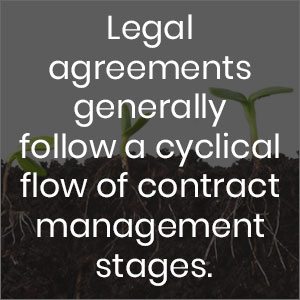Contract-centric business functions – like legal, finance, compliance, and sales operations – generally work best on a foundation of regimented, formulaic processes. The contract management process is no exception in this age of legal digital transformation. And that’s by both a natural evolution and strategic design.
Generally speaking, legal agreements follow a cyclical flow. Here, at ContractPodAi, we define these six stages of contract management as follows. Let’s explore each of these stages and the ways a modern contract lifecycle management (CLM) solution can make each more efficient and effective.
1. REQUEST
Businesses are always buying something significant, selling something important, partnering strategically, or hiring someone new. They need legally binding paperwork to move a business process forward and protect their company’s interests. Once a contract request is walked through the door to the corporate legal department, people, processes, and technology all shift into high gear.
The request might be satisfied by a standard contract like an employment offer letter, credit application, or a rental property lease agreement. Or it might require a complex contract with custom terms that need more preparation, research, and planning.
A contract management system offers a searchable repository of contracts, reusable terms, and pre-vetted language. This central repository can help a contract manager to satisfy a request much quicker, without adding unnecessary risk or approval processes. Integration with CRM applications, such as Salesforce, provides sales teams and services teams with better visibility into business relationships.
During this pre-contract, due diligence stage, though, it helps to identify the needs and expectations of your business and that of the other party.
Some questions, which might need addressing before assembling and negotiating contract terms with a prospective or existing customer, include:
- Are there pre-existing terms in place for pricing, delivery, or acceptance, such as with government supply agreements?
- Who will need to be involved in the execution and approval of the contract lifecycle stages?
- Are their historical precedents, as far as interactions with a particular client, supplier, or prospective partner, that ought to be considered
- Are there unique contract terms, based on a customer’s industry, that should be included?
As the saying goes, if you fail to plan for the unexpected in the pre-contract phase, plan to fail. For established businesses with a secure, searchable repository of successful contracts, not leveraging proven methods and tested language is a waste of intellectual capital.
2. GENERATE
Let’s say that you’ve decided that standard contract “boilerplate terms” won’t sufficiently address a business process, like hiring an executive-level employee or acquiring another company. A dynamic contract assembly and automation application can help you repurpose language from an integrated clause library.
That means that you can edit existing clauses for terms that are specific to the transaction at hand. Then, approval processes can be accelerated, paving the way for contract negotiations.
Further, a contract management system adds a level of professionalism to contracts while setting the tone for friendlier, more productive negotiations. And you can minimize time-consuming review by eliminating duplicate clauses, typos, and poorly worded or unapproved terms.
But at first, scan all of those paper contracts in your dust-coated filing cabinets. Then, OCR and index them. You can unlock a wealth of insights about your historical contract successes, which can be leveraged for future wins. Legal agreements generally follow a cyclical flow of contract management stages.
3. NEGOTIATION
When a draft agreement has been assembled and approved in principle by the powers that are in your organization, it’s time to negotiate the contract. Of course, it can be challenging to get all of the necessary “players” on every conference call or into every in-person meeting. So discussions over terms may occur outside of those meetings.
Next-generation CLM solutions, like ContractPodAi, offer advanced functionality, such as:
- Workflow and approval management to mitigate risk before a contract is shared outside your business
- Document version management, redlining, and comparisons to enable discussions around terms (They retain an audit trail should legal or financial regulators need to see how a contract evolved over time.)
- Collaborative customer negotiation portal that enables privileged users to collaboratively view and approve contract files from their approved device
Contract negotiations can be challenging, especially when you are working with another organization’s counsel who treats the process like a sport with winners and losers. Also, making the whole process more transparent and accessible can also make it far less adversarial.
4. ANALYZE
Are you looking to gain perspective about your contract renewal trends over time, make data-driven decisions about which suppliers to do business with, or get a visualization of your customer churn by industry? Your contract repository, as mentioned above, is a goldmine of insights. You just need an analysis tool to extract them.
Contract analytics can help your business reduce costs. With it, you can market to the industries or territories where you generate the best results. Are suppliers late on delivering inventory or components – those that you need to meet your production goals? Are some contract managers failing to use approved terms or spending too much time negotiating contracts?
The answers are in your contract repository. And you can find them with advanced reporting and dashboard analytics.
5. E-SIGNATURES
Once a contract has been authored and meets the goals defined in the initial request, the language is approved internally and accepted by a third party. But it’s kind of a buzzkill to put the contract into effect with old fashioned paper and ink. A broadly used e-signature app, like DocuSign, helps the parties to an agreement to sustain the positivity of a negotiated deal. What’s more, it empowers privileged executives to signal their approval and understanding of the terms of the relationship to the same extent as an ink signature would.
These days, e-Signatures are used for most types of agreements. Signing contracts with a pen seems like taking the checkered flag in a Formula 1 race and hitching the car to a team of horses to take the victory lap.
6. MANAGE
Once contracts are in force, it’s important to monitor whether each party is living up to the deliverables, milestones, and promises it made during negotiation.
If things are trending poorly, there may be penalties or even termination on the horizon. A contract management system sets the tone for more productive negotiations. And if things are going well, an extension or term renewal is more likely to happen. A contract’s lifecycle is most interesting after the award.
A contract management system, which provides visibility into the following performance metrics, can be the difference between a business with strong, recurring revenue numbers and one that struggles for its very survival:
- Likelihood of contract renewal
- Milestone and obligation tracking
- Notifications and alerts of pending autorenewals (in case you don’t want to continue doing business with a particular vendor or service provider)
ContractPodAi has already built a strong case for contract lifecycle management within legal teams. But it can be incredibly useful for people in finance and sales teams, too!
Here’s proof:
There are six stages of contract management. It’s nice that it’s an even number, and it makes for a tidy infographic like the one above. Automating contract review frees up contract managers and attorneys to work on multiple business pursuits at once. They can take pride in their clean, well-written contract language while reducing financial risk. They can get more done quicker, go home on time, and fully enjoy their personal lives! Contract negotiation portals can be accessed outside of the office, enabling executives to spend more time with customers, for instance. Spending less time on contract terms means more time communicating with colleagues about goals and strategies. With each processed and approved contract, your automated review bot gets a little smarter.
So, is your business looking for ways to better manage your contract cycle – from planning through to management and renewal?
Request a demo with ContractPodAi today. See firsthand how your business can efficiently navigate these contract stages – and successfully undergo a digital transformation of its own. Check out our Contract Management Primer for more information.
Author:

Sarvarth Misra
Connect with us on Linkedin





